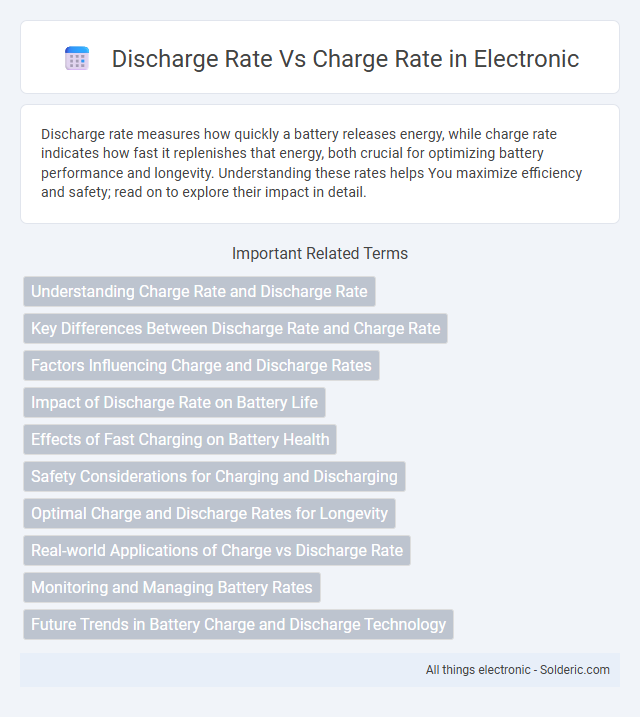Discharge rate measures how quickly a battery releases energy, while charge rate indicates how fast it replenishes that energy, both crucial for optimizing battery performance and longevity. Understanding these rates helps You maximize efficiency and safety; read on to explore their impact in detail.
Comparison Table
| Aspect | Discharge Rate | Charge Rate |
|---|---|---|
| Definition | Speed at which a battery releases stored energy | Speed at which a battery stores energy during charging |
| Measurement Unit | C-rate (e.g., 1C = full discharge in 1 hour) | C-rate (e.g., 1C = full charge in 1 hour) |
| Impact on Battery Life | High discharge rates can reduce battery lifespan | High charge rates may cause heat and degrade battery |
| Typical Values | 0.5C to 2C depending on battery type | 0.5C to 1C for standard lithium-ion batteries |
| Applications | Powering devices, peak load handling | Replenishing battery energy, fast charging |
| Safety Concerns | Excessive discharge can cause overheating, damage | Excessive charge rates risk thermal runaway |
Understanding Charge Rate and Discharge Rate
Charge rate, measured in C-rate, defines how quickly a battery replenishes its capacity, impacting charging time and battery longevity. Discharge rate, also expressed in C-rate, determines how fast energy is drawn from the battery, influencing device performance and operational duration. Precisely managing both the charge and discharge rates ensures optimal battery health and efficiency in applications ranging from electric vehicles to portable electronics.
Key Differences Between Discharge Rate and Charge Rate
Discharge rate measures how quickly a battery releases its stored energy, typically expressed in amperes (A), while charge rate indicates how fast a battery is replenished with energy, often represented as a fraction or multiple of its capacity (C-rate). High discharge rates can lead to faster battery depletion and increased heat generation, whereas optimal charge rates ensure battery longevity and prevent damage. Understanding these distinct parameters is crucial for applications like electric vehicles and renewable energy storage, where balancing efficient use and battery health is essential.
Factors Influencing Charge and Discharge Rates
Charge and discharge rates are influenced by factors such as battery chemistry, temperature, and state of health, directly affecting the efficiency and lifespan of your energy storage system. High charge rates can cause increased heat and stress, potentially reducing battery capacity over time, while discharge rates determine how quickly stored energy can be delivered to meet demand. Understanding these variables helps optimize performance and ensures safe operation of your rechargeable battery.
Impact of Discharge Rate on Battery Life
Higher discharge rates accelerate battery wear by increasing internal resistance, leading to elevated temperatures and reduced cycle life. Consistently discharging at rates exceeding manufacturer recommendations can cause capacity loss and premature battery failure. To optimize Your battery's lifespan, maintain discharge rates within specified limits to minimize physical and chemical degradation.
Effects of Fast Charging on Battery Health
Fast charging increases the discharge rate, causing higher heat generation and accelerated lithium-ion battery degradation due to increased electrode stress. Elevated discharge rates during rapid charge cycles lead to reduced capacity retention and shortened overall battery lifespan. Managing thermal conditions and implementing optimized charging protocols can mitigate adverse effects on battery health caused by fast charging.
Safety Considerations for Charging and Discharging
Safety considerations for charging and discharging lithium-ion batteries hinge on managing discharge rate versus charge rate to prevent overheating and thermal runaway. Excessive discharge rates can lead to internal short circuits and battery damage, while high charge rates increase the risk of lithium plating and capacity loss. Proper adherence to manufacturer-specified discharge and charge rates ensures optimal battery lifespan and reduces safety hazards during operation.
Optimal Charge and Discharge Rates for Longevity
Optimal charge and discharge rates are critical for maximizing battery longevity, with slower rates minimizing stress on battery cells and reducing capacity loss over time. Maintaining discharge rates below 1C and charging rates typically under 0.5C helps preserve electrode integrity and limits heat generation, key factors in extending battery lifespan. Battery management systems (BMS) often enforce these limits to balance performance and durability in lithium-ion and other rechargeable battery technologies.
Real-world Applications of Charge vs Discharge Rate
In electric vehicles, a high charge rate reduces downtime by enabling rapid battery replenishment, while a controlled discharge rate ensures optimal performance and longer battery life under varying load conditions. Renewable energy storage systems balance charge and discharge rates to maximize energy efficiency and grid stability, adapting to fluctuating power inputs and consumption demands. Consumer electronics prioritize fast charge rates for convenience and moderate discharge rates to prevent overheating and preserve battery health.
Monitoring and Managing Battery Rates
Monitoring battery discharge and charge rates is essential for optimizing battery lifespan and performance. Precise measurement of current flow during charging and discharging helps prevent overloading and overheating, reducing risks of capacity loss. Advanced battery management systems utilize real-time data to dynamically adjust charge and discharge rates, ensuring safe and efficient energy usage.
Future Trends in Battery Charge and Discharge Technology
Future trends in battery technology emphasize increasing charge and discharge rates to enhance energy efficiency and performance. Innovations in solid-state batteries and advanced electrode materials aim to reduce charging times while maintaining high discharge capacities for prolonged device use. You can expect improvements in fast charging protocols and thermal management systems to optimize battery lifespan and safety.
Discharge rate vs charge rate Infographic

 solderic.com
solderic.com